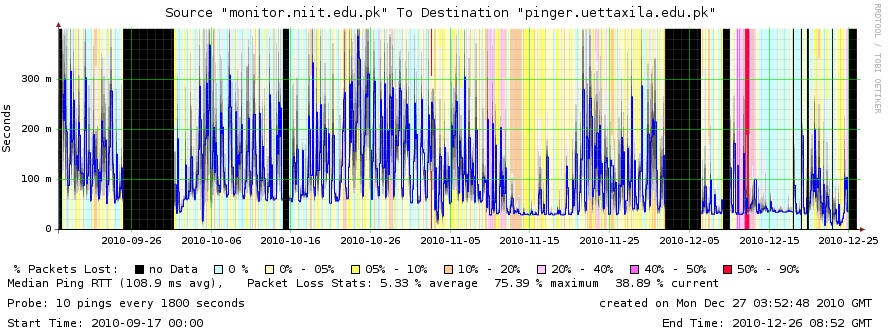As reported in the Sep-Oct 2010 HEC report, path from SEECS to UET Taxila is seeing high round trip times.
Looking at the [pingtable.pl data from SEECS to UETTaxila|http://pinger.seecs.edu.pk/cgi-bin/pingtable.pl?file=average_rtt&by=by-node&size=100&tick=monthly&from=Pakistan&to=PK.UETTAXILA.EDU.N1&ex=none&dataset=hep&percentage=any} results for Septeber results for September and October one sees:
- The monthly average RTTs are typically 100ms.
- The min_RTTs are under 10ms.
- The IPDV are typically quite large (> 20ms)
- Also the unreachability is high measured to UETAXILa from Pakistan
- The losses from SEECS to UET Taxila are between 2.5% and 7%, which is high
...
We decided to look at the data in more detail using http://pinger.fnal.gov/cgi-bin/graph_pings.pl?src_regexp=monitor.niit.edu.pk&dest_regexp=pinger.uettaxila.edu.pk and with the file format of csv. the format of the CSV output is:
| Code Block |
|---|
monitor.niit.edu.pk,pinger.uettaxila.edu.pk,100,10,10,60.117,86.823,138.175,3.4,22.6889,54.9,1,1602314766 |
...
i.e. |
...
Mon-name,remote-name,ping_size,sent,rcvd,min_RTT,avg_RTT,max_RTT,min_IPV,IPDV,max_IPV,Dups,unix_time+10years(GMT) |
...
|
This was imported into Excel, the Unix time converted to Excel time day using Excel=Unix/(60*60*24)+"1/1/1970"
and then plot time of day versus average RTT, ipdv, max RTT. We also looked for correlations with day of the week. The results show little correlation with time of day or day of week.
This may be patrially caused by the large bins being used by graph_pings.pl. To eliminate this we will look at the half hourly data gathered into files of the form:
| Code Block |
|---|
/nfs/slac/g/net/pinger/pingerdata/hep/data/monitor.niit.edu.pk/ping-2010-12-26.txt.gz
|
